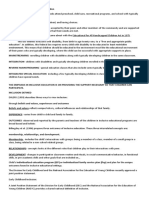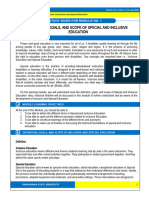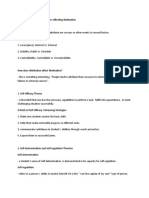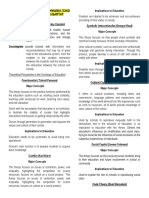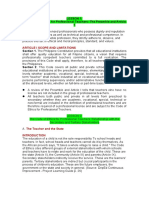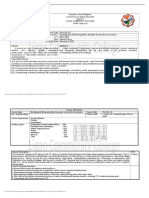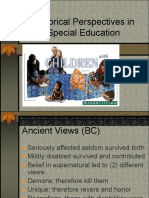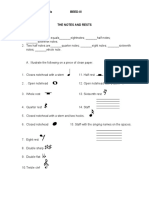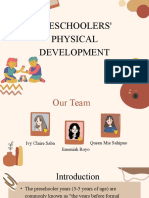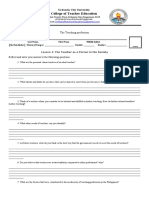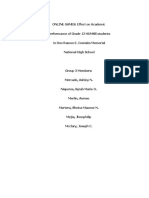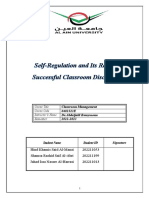Lecture Notes 9
Uploaded by
MERCADO APRIL ANELecture Notes 9
Uploaded by
MERCADO APRIL ANEFoundation of Special Education and Inclusive Education
Module 9 – Learner with difficulty remembering and focusing/Intellectual Disability
LEARNING OBJECTIVES
At the end of the module, you are expected to be able to:
1. distinguish the different types, identifications, etiologies, causes, characteristics of learner with
difficulty remembering and focusing;
2. describe the different types and levels/degrees, etiologies, causes and characteristics of these
learners; and
3. demonstrate knowledge of teaching strategies that are inclusive of learners with difficulty
remembering and focusing.
Learning Outline
Lesson 1. Description of Intellectual Disability
Lesson 2. Causes and Prevention of Intellectual Disability
Lesson 3. Teaching Strategies
Lesson 1. Description of Intellectual Disability April ane
Intellectual disability is a substantial limitation in cognitive functioning (i.e., thinking
skills). People with intellectual disability usually have limited communication skills, limited self-care
skills, poor social skills, and very limited academic skills. Most importantly, people with intellectual
disabilities have great difficulty with learning and usually require special teaching methods to
learn efficiently.
A person with mild intellectual disability usually has severe learning difficulties, limited or poor
conversational skills and would usually have a history of slow personal development. Most people
with mild intellectual disability learn independent living skills and are usually involved in productive
work at home, in the community or in a workplace.
A person with moderate intellectual disability usually has very severe learning difficulties, very
poor communication skills and very slow personal development. For example, it may take a student
with moderate intellectual disability up to several years to learn very simple academic skills such as
writing their own name, recognizing 50 sight words, counting and counting objects, and performing
simple arithmetic operations. People with moderate intellectual disabilities do not usually learn all the
living skills they need to live independently, without the support of family or other carers. However,
people with moderate intellectual disabilities often learn some productive role in their home or village
and some have been able to gain limited employment.
Module 1 – Issues and Early Approaches to Literary Criticism | Page 1 of 5
A person with a severe intellectual disability is usually not able to perform academic tasks, is
unlikely to develop or learn self-care skills and may not learn or develop ordinary communication
skills. Pictorial communication systems (using pictures to communicate) have been successful, in some
cases, in teaching students with severe intellectual disabilities to communicate choices and needs.
People with severe intellectual disabilities do not learn to live independently and require ongoing
support for their survival.
In the past, intellectual disability was called mental retardation, a term that continues to be used in some
textbooks. People with intellectual disability have formed international associations aimed at eliminating
discrimination against people with intellectual disability, and these organizations have asked governments
and others to use the term person with an intellectual disability instead of person who is mentally
retarded. For that reason, most authors nowadays use person (or student, child, etc.) with an intellectual
disability.
Lesson 2. Causes and Prevention of Intellectual Disability Roselle
Intellectual disability is the result of damage to the brain. Damage to the brain can be a
result of a developmental or genetic disorder (such as Down syndrome (see Hall, 1994, pp.40-
41), a disease before or after birth, or a trauma before or after birth. In individual cases it is
often not possible to identify the cause of intellectual disability. Some known causes are:
Genetic conditions Abnormalities in genes inherited from parents, errors when
genes combine or damage to genes during or before pregnancy
from disease, radiation or poisoning. Examples include
Down syndrome and Fragile X syndrome.
Problems during Poisoning of the unborn baby from alcohol or other drugs;
pregnancy malnutrition; illnesses of the mother
Problems at birth
(e.g., rubella, toxoplasmosis, venereal disease, HIV,
Problems after birth Diseases such as whooping cough, chicken pox, measles,
cytomegalovirus)
meningitis, malaria, encephalitis; head injury from
accidents or abuse;
Prematurity;
oxygen deprivation
low birth weight;
from near-
injury at birth due to
complications
drowning; poisoning; ingestion of pollutants; malnutrition;
high fever.
Some of these causes also cause other disabilities so some people have multiple disabilities. For
example, students with Down syndrome usually have intellectual disability but often also have
medical problems. Students with cerebral palsy, often caused by fever of oxygen deprivation before
Module 1 – Issues and Early Approaches to Literary Criticism | Page 2 of 5
or during birth, usually have significant physical disabilities but sometimes also have intellectual
disability. Babies born with intellectual disability due to the mother having rubella during pregnancy,
often have deafness or blindness, or both. Roselle
lyka
Prevention
Preventative measures that parents and others can take to reduce the risk of intellectual
disability include:
Before birth
• Avoid alcohol, smoking and other drugs
• Avoid HIV and other sexually transmitted diseases
• Have a good diet and a healthy lifestyle
• Obtain plenty of rest and avoid strain and overwork
• Seek medical assistance for any illness or infection
After birth
• Eliminate child abuse or neglect
• Avoid accidents and injury
• Obtain proper immunization against disease
• Avoid malaria
• Ensure that the child has a healthy diet and a healthy, active lifestyle
• Avoid dirty or polluted water
• Prevent infections by only using clean food and have good hygiene practices lyka
Lesson 3. Teaching strategies lalaine
The most important thing for teachers to understand about students with mild or moderate
intellectual disabilities is that they will have serious learning difficulties and will not be able to access
the whole school curriculum. Teachers need to discuss the student’s needs with the student’s parents,
and work out some educational priorities for the student. The student’s learning at school will be
limited so the teacher must make sure that the educational objectives set for the student are
important, achievable and useful. The teacher must also utilize peer tutors and others, if available, to
assist the student with learning. The student’s learning will occur gradually and the student will always
have difficulty, so the teacher needs to teach skills in small steps using task analysis and make sure that
all instruction is clear and direct.
Partialparticipation. All of the material in the primary school curriculum is useful and
important. However, only some material is absolutely essential for every student to learn. Students
with intellectual disability cannot cover an entire curriculum so teachers, in collaboration with the
student’s parents, have to decide which curriculum outcomes to concentrate on and then focus on
those ones only. While other students might be working on many curriculum outcomes at a time, a
student with an intellectual disability will probably only be working towards three or four curriculum
outcomes in a school term, and may only be working on one or two objectives on each school day.
Students with intellectual disability, like all other students, need to be involved in regular school
activities with other students but, unless the teacher has access to specialist assistance, the teacher
Module 1 – Issues and Early Approaches to Literary Criticism | Page 3 of 5
will only be able to provide a limited amount of instruction to the student. Effective teachers make sure
that students with intellectual disabilities are included in as many regular school activities as possible
but they can only provide instruction on one or two objectives for each student with a disability each
day.
Functional curriculum. Because students with intellectual disability learn very slowly, what they learn
should be functional (i.e., useful in their daily lives). Functional skills areusually basic communication
skills, self-care skills, personal safety, money management, survival reading skills, social skills and
practical skills for making a living. Teachers should use real, practical materials for teaching functional
skills, and, if possible, ensure that students practice their skills in real contexts. Parents can be a great
help to teachers in this regard. lalaine
Jan mhar
1. Make learningfun Remember, students with intellectual disabilities have as much right to be at
school as any other child. To teach these students well, teachers have to treat them with dignity
and respect, and make learning fun. Teachers should use plenty of encouragement, patience and
praise to build up confidence and feelings of success. For young students, or students who aren’t
used to attending school, it is also important to make sure that the student is attentive. Setting
up listening games and other listening activities, making sure that students are engaged with
other students, and, overall, making the classroom an interesting and busy environment, is a good
set of strategies to use to encourage attentiveness.
2. Task analysis Breaking simple tasks into smaller, teachable steps, is a very important and useful
teaching strategy for students with intellectual disability. While a task may be too difficult for a
student to learn, if it’s broken down into smaller steps, the student may learn to do all of it or
some of it gradually. Most tasks can be broken down in this way. Students with intellectual
disability need lots of repetition and practice before steps are truly learned and they also need to
perform their learning tasks with different materials and in different contexts to generalize their
skills. Teachers should always reinforce students’ attempts and successes. Teachers need to
monitor students’ performances regularly and keep a record of progress. If an approach to
teaching isn’t resulting in any progress, then the teacher should find a different way to teach it.
Remember, if the student isn’t learning, then the teacher hasn’t found the right way to teach
that skill.
3. Peer tutoring In a big, busy, crowded classroom, a teacher cannot give any one student much
more than a few minutes of individual instruction each day. While those few minutes are very
important and useful, teachers should always use other students, parents and any other helpers
to also help with students with disabilities. Students with intellectual disability learn best through
regular, daily instruction and the instruction doesn’t need to be lengthy. Peer tutors or other
helpers can provide just a few extra minutes of instruction for the student each day, and make a
very big difference to the student’s rate of learning. Cooperative learning strategies are also an
excellent way to include students with disabilities in learning and other school activities.
References
Module 1 – Issues and Early Approaches to Literary Criticism | Page 4 of 5
https://tinyurl.com/y3yj9aqc
https://www.academia.edu/31598778/Questions_About_Special_Education_pdf
https://tinyurl.com/y5oz4syw
https://tinyurl.com/y6mrdfxt
https://tinyurl.com/yxechzul
DO 21 s2020, https://tinyurl.com/y2ewmmso retrieved September 5, 2020
https://tinyurl.com/y5z7poej, retrieval date September 5, 2020
https://tinyurl.com/zqwo99y retrieved September 5, 2020
Module 1 – Issues and Early Approaches to Literary Criticism | Page 5 of 5
You might also like
- How To Draw Noir Comics The Art and Technique of Visual Storytelling PDF - Compress0% (1)How To Draw Noir Comics The Art and Technique of Visual Storytelling PDF - Compress5 pages
- Ivs233 Investment Property Under ConstructionNo ratings yetIvs233 Investment Property Under Construction7 pages
- An Inclusive Approach To Early EducationNo ratings yetAn Inclusive Approach To Early Education3 pages
- Unit 3: Bases and Policies of Special and Inclusive EducationNo ratings yetUnit 3: Bases and Policies of Special and Inclusive Education7 pages
- Cpe 103 Inclusive Ed Module 1 Def Goals N Scope of SN I Ed2023finalNo ratings yetCpe 103 Inclusive Ed Module 1 Def Goals N Scope of SN I Ed2023final45 pages
- Unit 7: Strategies For Teaching Geographic Concepts and SkillsNo ratings yetUnit 7: Strategies For Teaching Geographic Concepts and Skills14 pages
- MODULE 9 - Week 3 - The Child and Adolescent Learners and Learning PrinciplesNo ratings yetMODULE 9 - Week 3 - The Child and Adolescent Learners and Learning Principles9 pages
- Biological and Environmental Causes of Developmental DisabilitiesNo ratings yetBiological and Environmental Causes of Developmental Disabilities45 pages
- Chapter 2. L2. Philosophical Foundations of EducationNo ratings yetChapter 2. L2. Philosophical Foundations of Education10 pages
- Zosimo, Ed 4 - 20240515 - 230757 - 0000No ratings yetZosimo, Ed 4 - 20240515 - 230757 - 000031 pages
- Foundation of Special and Inclusive Education100% (1)Foundation of Special and Inclusive Education38 pages
- Role of Early Intervention in Inclusive Education 1No ratings yetRole of Early Intervention in Inclusive Education 130 pages
- Module 20: Theories On Factors Affecting MotivationNo ratings yetModule 20: Theories On Factors Affecting Motivation2 pages
- Chapter 3 Meaning of Special Education and Categories of Children With Special NeedsNo ratings yetChapter 3 Meaning of Special Education and Categories of Children With Special Needs20 pages
- Bases and Policies of Special and Inclusive Education: Module 7-8 (Finals)No ratings yetBases and Policies of Special and Inclusive Education: Module 7-8 (Finals)24 pages
- Prof. Ed. 10 Building Enhancing New Literacies Across The CurriculumNo ratings yetProf. Ed. 10 Building Enhancing New Literacies Across The Curriculum6 pages
- LESSON 8.4 The Teacher and The Sch. Cur.No ratings yetLESSON 8.4 The Teacher and The Sch. Cur.9 pages
- Lesson 3. Educational Reforms The K To 12 Curriculum ExampleNo ratings yetLesson 3. Educational Reforms The K To 12 Curriculum Example6 pages
- Lesson 3 Historical Perspectives in Special EducationNo ratings yetLesson 3 Historical Perspectives in Special Education17 pages
- Module 2 Physical Fitness and Wellness.pptxNo ratings yetModule 2 Physical Fitness and Wellness.pptx51 pages
- Research and Information Gathering Task - ED 204 (Group 13)No ratings yetResearch and Information Gathering Task - ED 204 (Group 13)106 pages
- Learners With Additional Needs: "Students Need To Belong, Before They Can Truly Achieve."No ratings yetLearners With Additional Needs: "Students Need To Belong, Before They Can Truly Achieve."25 pages
- Activity1 Assignment 1 Building and Enhancing LiteraciesNo ratings yetActivity1 Assignment 1 Building and Enhancing Literacies2 pages
- HUMSS Students in Don Ramon E. Costales Memorial National High SchoolNo ratings yetHUMSS Students in Don Ramon E. Costales Memorial National High School3 pages
- Community Health, 1-3. Area of Concern & Relevance To Occupational Therapy PracticeNo ratings yetCommunity Health, 1-3. Area of Concern & Relevance To Occupational Therapy Practice3 pages
- Private Practice - Grey's Anatomy Episode OrderNo ratings yetPrivate Practice - Grey's Anatomy Episode Order7 pages
- Differences and Similarities Between L1 & L2 Acquisition100% (1)Differences and Similarities Between L1 & L2 Acquisition33 pages
- Acoustic Indices For Biodiversity Assessment and Landscape InvestigationNo ratings yetAcoustic Indices For Biodiversity Assessment and Landscape Investigation10 pages
- Mr. Sachin Jaysawal So Om Prakash Imampur Chanaipur Ambedkar Nagar, Up - 224168 Uttar Pradesh, IndiaNo ratings yetMr. Sachin Jaysawal So Om Prakash Imampur Chanaipur Ambedkar Nagar, Up - 224168 Uttar Pradesh, India8 pages
- Presentation On Leadership Skills and Change ManagementNo ratings yetPresentation On Leadership Skills and Change Management23 pages
- How To Draw Noir Comics The Art and Technique of Visual Storytelling PDF - CompressHow To Draw Noir Comics The Art and Technique of Visual Storytelling PDF - Compress
- Unit 3: Bases and Policies of Special and Inclusive EducationUnit 3: Bases and Policies of Special and Inclusive Education
- Cpe 103 Inclusive Ed Module 1 Def Goals N Scope of SN I Ed2023finalCpe 103 Inclusive Ed Module 1 Def Goals N Scope of SN I Ed2023final
- Unit 7: Strategies For Teaching Geographic Concepts and SkillsUnit 7: Strategies For Teaching Geographic Concepts and Skills
- MODULE 9 - Week 3 - The Child and Adolescent Learners and Learning PrinciplesMODULE 9 - Week 3 - The Child and Adolescent Learners and Learning Principles
- Biological and Environmental Causes of Developmental DisabilitiesBiological and Environmental Causes of Developmental Disabilities
- Chapter 2. L2. Philosophical Foundations of EducationChapter 2. L2. Philosophical Foundations of Education
- Role of Early Intervention in Inclusive Education 1Role of Early Intervention in Inclusive Education 1
- Module 20: Theories On Factors Affecting MotivationModule 20: Theories On Factors Affecting Motivation
- Chapter 3 Meaning of Special Education and Categories of Children With Special NeedsChapter 3 Meaning of Special Education and Categories of Children With Special Needs
- Bases and Policies of Special and Inclusive Education: Module 7-8 (Finals)Bases and Policies of Special and Inclusive Education: Module 7-8 (Finals)
- Prof. Ed. 10 Building Enhancing New Literacies Across The CurriculumProf. Ed. 10 Building Enhancing New Literacies Across The Curriculum
- Lesson 3. Educational Reforms The K To 12 Curriculum ExampleLesson 3. Educational Reforms The K To 12 Curriculum Example
- Lesson 3 Historical Perspectives in Special EducationLesson 3 Historical Perspectives in Special Education
- Research and Information Gathering Task - ED 204 (Group 13)Research and Information Gathering Task - ED 204 (Group 13)
- Learners With Additional Needs: "Students Need To Belong, Before They Can Truly Achieve."Learners With Additional Needs: "Students Need To Belong, Before They Can Truly Achieve."
- Activity1 Assignment 1 Building and Enhancing LiteraciesActivity1 Assignment 1 Building and Enhancing Literacies
- HUMSS Students in Don Ramon E. Costales Memorial National High SchoolHUMSS Students in Don Ramon E. Costales Memorial National High School
- Community Health, 1-3. Area of Concern & Relevance To Occupational Therapy PracticeCommunity Health, 1-3. Area of Concern & Relevance To Occupational Therapy Practice
- Differences and Similarities Between L1 & L2 AcquisitionDifferences and Similarities Between L1 & L2 Acquisition
- Acoustic Indices For Biodiversity Assessment and Landscape InvestigationAcoustic Indices For Biodiversity Assessment and Landscape Investigation
- Mr. Sachin Jaysawal So Om Prakash Imampur Chanaipur Ambedkar Nagar, Up - 224168 Uttar Pradesh, IndiaMr. Sachin Jaysawal So Om Prakash Imampur Chanaipur Ambedkar Nagar, Up - 224168 Uttar Pradesh, India
- Presentation On Leadership Skills and Change ManagementPresentation On Leadership Skills and Change Management


